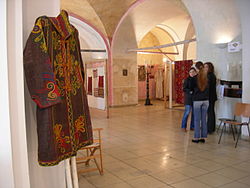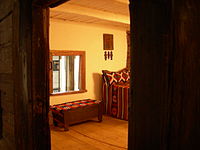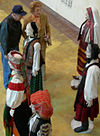| Revision as of 00:18, 6 August 2018 editInternetArchiveBot (talk | contribs)Bots, Pending changes reviewers5,385,989 edits Rescuing 1 sources and tagging 0 as dead. #IABot (v2.0beta5)← Previous edit | Revision as of 17:16, 28 September 2018 edit undoGreenC bot (talk | contribs)Bots2,555,724 edits Rescued 1 archive link; reformat 1 link. Wayback Medic 2.1Next edit → | ||
| Line 7: | Line 7: | ||
| ] | ] | ||
| First founded in 1906 by and originally managed by ], the museum was reopened February 5, 1990, a mere six weeks after the downfall and execution of ]. During the ], the building housed a museum representing the country's Communist party; the museum's basement still contains a room devoted to an ] display of some artifacts from that earlier museum.<ref>{{Cite web |url=http://www.roughguides.com/destinations/europe/romania/bucharest/museum-romanian-peasant/ |title=Archived copy |access-date=2016-04-09 |archive-url=https://web.archive.org/web/20160419235255/http://www.roughguides.com/destinations/europe/romania/bucharest/museum-romanian-peasant/ |archive-date=2016-04-19 |dead-url=yes |df= }}</ref> The building, which uses traditional Romanian architectural features, was built on the former site of the State ] (''Monetăria Statului'').{{cn|date=December 2016}} Initially intended as a museum of Romanian art, it was designed by ] and built between 1912 and 1941.<ref>{{ro icon}} at the Museum of the Romanian Peasant site</ref> The building is listed as a ] by Romania's ].<ref>{{ro icon}} |
First founded in 1906 by and originally managed by ], the museum was reopened February 5, 1990, a mere six weeks after the downfall and execution of ]. During the ], the building housed a museum representing the country's Communist party; the museum's basement still contains a room devoted to an ] display of some artifacts from that earlier museum.<ref>{{Cite web |url=http://www.roughguides.com/destinations/europe/romania/bucharest/museum-romanian-peasant/ |title=Archived copy |access-date=2016-04-09 |archive-url=https://web.archive.org/web/20160419235255/http://www.roughguides.com/destinations/europe/romania/bucharest/museum-romanian-peasant/ |archive-date=2016-04-19 |dead-url=yes |df= }}</ref> The building, which uses traditional Romanian architectural features, was built on the former site of the State ] (''Monetăria Statului'').{{cn|date=December 2016}} Initially intended as a museum of Romanian art, it was designed by ] and built between 1912 and 1941.<ref>{{ro icon}} at the Museum of the Romanian Peasant site</ref> The building is listed as a ] by Romania's ].<ref>{{ro icon}} </ref> | ||
| The museum was devastated during the June 1990 ], due to being confused with the headquarters of the ]. | The museum was devastated during the June 1990 ], due to being confused with the headquarters of the ]. | ||
Revision as of 17:16, 28 September 2018

The National Museum of the Romanian Peasant (Template:Lang-ro) is a museum in Bucharest, Romania, with a collection of textiles (especially costumes), icons, ceramics, and other artifacts of Romanian peasant life. One of Europe's leading museums of popular arts and traditions, it was designated "European Museum of the Year" for 1996.
Located on Șoseaua Kiseleff, near Piaţa Victoriei, the museum falls under the patronage of the Romanian Ministry of Culture. Its collection includes over 100,000 objects.

First founded in 1906 by and originally managed by Alexandru Tzigara-Samurcaş, the museum was reopened February 5, 1990, a mere six weeks after the downfall and execution of Nicolae Ceauşescu. During the Communist era, the building housed a museum representing the country's Communist party; the museum's basement still contains a room devoted to an ironic display of some artifacts from that earlier museum. The building, which uses traditional Romanian architectural features, was built on the former site of the State Mint (Monetăria Statului). Initially intended as a museum of Romanian art, it was designed by Nicolae Ghica-Budești and built between 1912 and 1941. The building is listed as a historic monument by Romania's Ministry of Culture and Religious Affairs.
The museum was devastated during the June 1990 Mineriad, due to being confused with the headquarters of the National Peasants' Party.

One of the museum's most famous exhibits—originally the work of Tzigara-Samurcaș—is "the house in the house". The house, which originally belonged to peasant Antonie Mogos of Ceauru village in Gorj County. From the first, the house was displayed in a non-naturalistic way: objects that would normally be in the interior were displayed in various manners outside; outbuildings were suggested by fragments. The Communist regime displayed the house much more conventionally, outdoors at the Village Museum; it returned to the Peasant Museum in 2002. The current display at the Peasant Museum revives the original non-naturalistic approach. For example, from a platform, museum visitors may peer into the attic, part of whose wall is stripped away; various objects are arranged inside.
In 2002, the museum's exhibit space was greatly expanded as the museum store and offices moved into a new building behind the old one, freeing up a considerable amount of floor space in the museum proper.
Gallery
Notes
- All awards 1977-2003, European Museum Forum. Accessed online 4 April 2007.
- "Archived copy". Archived from the original on 2016-04-19. Retrieved 2016-04-09.
{{cite web}}: Unknown parameter|dead-url=ignored (|url-status=suggested) (help)CS1 maint: archived copy as title (link) - Template:Ro icon Clădire at the Museum of the Romanian Peasant site
- Template:Ro icon Lista Monumentelor Istorice 2010: București
- "The house in the house", wall text, Museum of the Romanian Peasant.
External links
44°27′15.78″N 26°5′1.24″E / 44.4543833°N 26.0836778°E / 44.4543833; 26.0836778
Categories:





